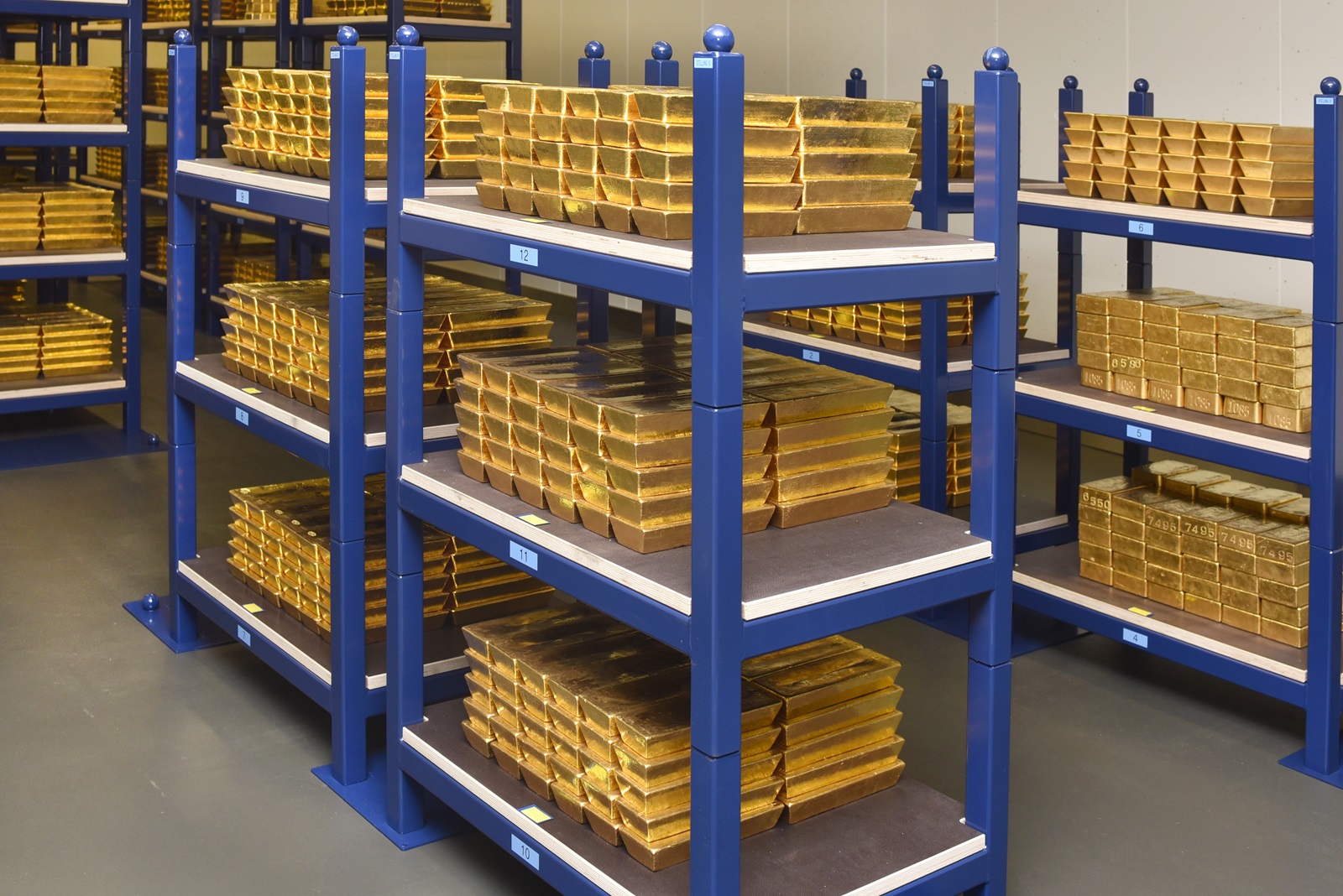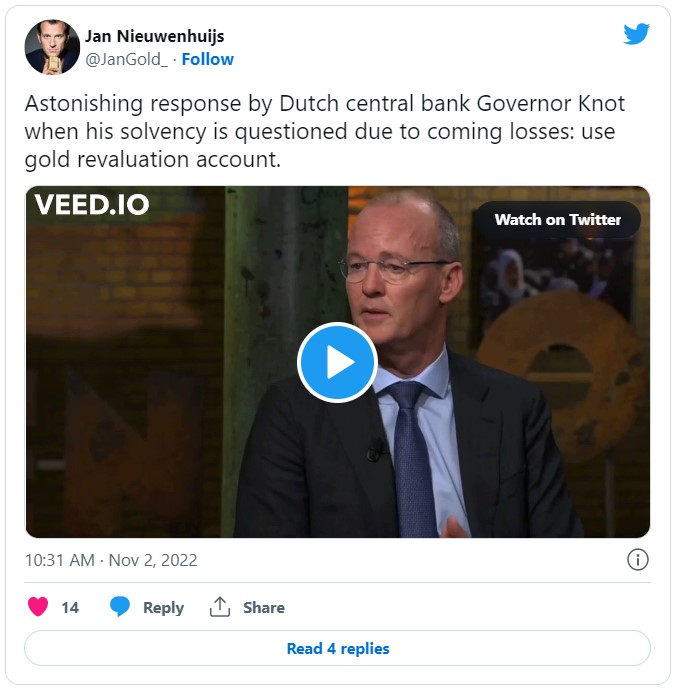Governor of Dutch Central Bank States Gold Revaluation Account Is Solvency Backstop
The Governor of the Dutch central bank stated the gold revaluation account ensures the solvency of his central bank in an interview on television about prospective losses. The significance of this statement is that if any European central bank will cover losses by using its gold revaluation account in full, the ECB has to put a floor under the gold price. And if more losses need to be covered than the current gold revaluation accounts of European central banks allow, the ECB will need to revalue gold.
Monetary gold reserves of the Netherlands. Source: DNB
Introduction
A discussion has commenced in the Netherlands after Klaas Knot, Governor of the Dutch central bank (DNB), wrote a letter to Sigrid Kaag, Dutch Minister of Finance, on September 9, 2022. The letter is titled: “DNB foresees deterioration of capital position.” Knot warns Kaag of DNB losses due to interest rate hikes—decided by the European Central Bank (ECB) but applied by all National Central Banks (NCBs) of the Eurosystem. In recent years Quantitative Easing (QE) has made DNB, and all other NCBs, create an abundance in bank reserves to buy government bonds. Now the ECB is raising interest rates DNB has to pay banks more and more interest over their excess reserves. These expenditures cause DNB to suffer losses to the detriment of its capital position (equity). Note, all NCBs in the Eurosystem face similar challenges.
For this year DNB expects a small loss but for the years 2023 through 2026 a loss of €9 billion euros is expected. Though, it could be more. DNB’s equity is currently €11.3 billion. If the losses exceed €11.3 billion, DNB’s equity will become negative. Although it’s possible for a central bank to operate under negative equity, it does hurt credibility—a central bank’s most valuable asset. And once credibility is lost people will dump the currency issued by said central bank.
For this reason, Knot wants to discuss with the Dutch state (DNB’s sole shareholder) the possibilities of funding a recapitalization of DNB. In other words, if taxpayers can bail-out their central bank.
The Gold Revaluation Account as a Solvency Backstop
A gold revaluation account (GRA) is basically an accounting item that records the unrealized gains of a central bank’s gold. Because most of Europe’s monetary gold was accumulated during Bretton Woods at $35 dollars an ounce, the respective GRAs are substantial. Monetary gold in the Eurosystem is marked to market and the gold price today is much higher than $35.
Below is a simplified balance sheet of a central bank. On the asset side there are international reserves (gold and foreign exchange), a bond portfolio, and discount loans to commercial banks. On the liability side there is the monetary base (reserves and currency), a deposit account for the government, a GRA, and equity.
Like commercial banks, the balance sheet of a central bank includes assets and liabilities.
Interestingly, there is no limit on a GRA because gold is the only international reserve asset that can’t be printed. Denominated in fiat currencies, which can and are printed, the gold price doesn’t have a ceiling and it can inflate balance sheets likewise.
The GRA can be seen as equity but technically it isn’t at this point because it’s prohibited from being used. The current laws in the E.U. dictate: “there shall be no netting of unrealized losses in any one security, or in any currency or in gold holdings against unrealized gains in other securities or currencies or gold.” At this stage the GRA just swells and shrinks in sync with the rise and fall of the price of gold. But all this might change.
On Sunday October 30, 2022, Knot was interviewed by Buitenhof about DNB’s losses. When the solvency of DNB’s balance sheet was questioned Knot brought up the GRA.
Interviewer: So, what you're saying is that the higher the interest rate by the European Central Bank, the more expensive it gets for us ...
Knot: Yes, that is correct ...
Interviewer: ... and the more money is needed. Hold on, I want to finish my question, so we all understand. And the higher the probability the Dutch taxpayer has to pay to fix the balance sheet of the Dutch central bank of which I always thought, "that's solid, it can't fail." This story is new to me.
Knot: The balance sheet of the Dutch central banks is solid because we also have gold reserves and the gold revaluation account is more than 20 billion euros, which we may not count as equity, but it is there.
Interviewer: But you don't want to sell the gold?
Knot: No, we're definitely not going to sell.
Using the GRA to cover losses doesn’t require selling gold, it requires changing the accounting rules. The reason it’s now prohibited from being used is because once fully run down a declining gold price will cause the GRA to become negative, eating into DNB’s net worth. The very thing DNB is trying to avoid. In the interview Knot thus appoints the GRA as a solvency backstop, but this implies putting a floor under the gold price.
This February I published an article about the possibility of European central banks revaluing gold and subsequently using their GRAs to cancel sovereign bonds as debt relief for governments. My analysis was based on an email exchange between me and the German central bank in which they stated they don’t rule out this possibility. In October I revealed that European central banks have equalized, proportionally to GDP, their gold reserves among each other in the past decades. This was done for all to enjoy the same relative gain in their GRAs when revaluing gold. According to my assessment, revaluing gold will only be done in an insurmountable crisis. After the gold revaluation sovereign debt would be cancelled, the gold price stabilized, and the eurozone effectively moves towards a new version of a gold standard.
In the 1930s GRAs had been used for several purposes. After devaluing against gold central banks eventually re-pegged their currencies to gold at a higher price, leaving GRAs to be used as they saw fit. As far as I know, no central banker has openly discussed using a GRA—to cover its own losses or cancel sovereign bonds—since Bretton Woods. Remarkably, in Buitenhof it wasn’t the interviewer that brought up the GRA, it was Knot! Since the word is out, central banks in Europe officially stand ready to change the rules and use their GRAs to guarantee their own solvency. In addition, once the rules are changed, it allows them to revalue gold and bail-out their governments too.
In final, the current trend is clear: financial challenges, caused by unconventional monetary policy, lead to more focus on gold’s role in overcoming these challenges. And I will be closely monitoring these developments.
Read more from the author about developments in the international gold market:
Europe Has Been Preparing a Global Gold Standard Since the 1970s. Part 2
Swiss Central Bank Moved Its Gold From Berne to a Federal Bunker in Kandersteg
Is the Russian Ruble Linked to Gold?
Austrian Monetary Gold Transfer from London to Switzerland—Planned in 2015—Still Hasn't Arrived
Denmark Releases Gold Bar List, But the Serial Numbers Are Missing
France Has Repatriated All Its Monetary Gold

